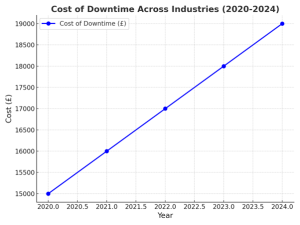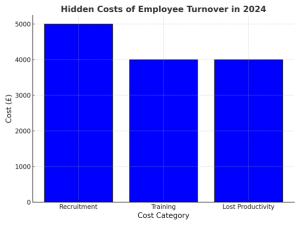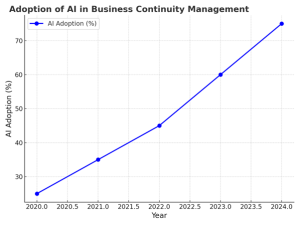In the fast-paced world of business, where every minute counts and competition grows fiercer by the day, the concept of business continuity is no longer a luxury—it’s a necessity. Yet, many organizations in the UK overlook the less obvious costs tied to inadequate business continuity management (BCM). These hidden expenses can creep up, erode profitability, and put businesses at risk of collapse. Could these challenges be silently threatening your organization? And is tackling them easier than you think? Let’s explore the hidden costs, their implications, and how to safeguard your business with the right strategies.
The Current State of Business Continuity Management
As we near the end of 2024, the stakes for effective business continuity management have never been higher. From cyberattacks to supply chain disruptions and unexpected market shifts, organizations must be prepared to respond effectively. But here’s the catch: many businesses fail to account for the hidden costs of poor BCM, which can range from operational inefficiencies to long-term reputational damage.
1. Rising Costs of Downtime
In today’s economy, downtime is more expensive than ever. A 2024 report the average cost of an hour of downtime for UK businesses has reached £19,000, up 12% from 2023. For SMEs, even a single day of disruption can result in devastating financial losses.

2. Cybersecurity Threats
With cyberattacks on the rise, businesses face heightened risks of data breaches and ransomware. The average ransomware attack in 2024 costs UK businesses £230,000, including recovery expenses and reputational harm. Yet, many organizations lack robust continuity plans to mitigate these risks effectively.
3. Supply Chain Vulnerabilities
Global supply chains remain fragile, with disruptions affecting everything from raw materials to end-user delivery. 40% of UK businesses experienced significant supply chain issues in 2024, with financial losses averaging £75,000 per incident.
4. Employee Productivity Losses
Inadequate BCM can also lead to inefficiencies in the workforce. Employees working in unstructured or reactive environments spend 20% more time managing disruptions, reducing overall productivity and morale.

5. Increasing Regulatory Pressure
As governments worldwide tighten regulations on data security and disaster recovery, businesses that fail to implement adequate BCM measures face significant penalties. Fines related to GDPR violations alone have averaged £15 million annually in the UK for non-compliance incidents involving data recovery failures.
The Hidden Costs of Poor Business Continuity Management
Beyond the visible financial losses, poor business continuity management incurs a range of hidden costs that can quietly erode organizational resilience:
1. Reputational Damage
In today’s hyper-connected world, customers and stakeholders expect businesses to operate seamlessly. A poorly handled disruption can lead to lasting reputational damage, with 60% of customers in a 2024 UK survey indicating they would switch to a competitor after just one negative experience. Social media amplifies these effects, making damage control even more challenging.
2. Regulatory Penalties
With stricter compliance requirements in place, businesses that fail to demonstrate adequate continuity planning risk fines and penalties. For instance, breaches of GDPR regulations due to poor data recovery processes have resulted in penalties averaging £200,000 per incident. Compliance failures related to BCM are becoming a frequent area of scrutiny during audits.
3. Missed Opportunities
While managing disruptions, businesses often miss out on growth opportunities. Without a robust continuity plan, organizations may struggle to capitalize on market openings, costing them potential revenue and market share. 45% of businesses delayed strategic initiatives due to operational disruptions.
4. Employee Turnover
Stressful and disorganized workplaces drive higher employee turnover. The cost of replacing a single employee in 2024 is estimated at £13,000, including recruitment, training, and lost productivity. High turnover further weakens a company’s ability to respond to disruptions effectively.

5. Operational Inefficiencies
Fragmented processes and untested continuity plans lead to slower recovery times and higher costs. Organizations without automated backup systems or cloud-based solutions spend 35% longer restoring critical operations, compounding financial losses.
Tackling Business Continuity Challenges
The good news? With the right approach, addressing these hidden costs is entirely feasible. Here’s how organizations can fortify their business continuity management strategies:
1. Conduct Comprehensive Risk Assessments
Identify vulnerabilities across your organization, from IT systems to supply chain dependencies. Use tools like scenario analysis and predictive modeling to quantify potential impacts and prioritize mitigation efforts. Regular risk assessments are essential for adapting to evolving threats and ensuring preparedness.
2. Invest in Technology
Modern BCM solutions powered by AI and machine learning can provide real-time risk monitoring, automate recovery processes, and ensure seamless communication during disruptions. For instance, AI-driven incident management platforms can reduce response times by 40% and enhance coordination across departments.

3. Train Your Workforce
Equip employees with the skills and knowledge to respond effectively to disruptions. Regular training sessions, simulated drills, and clear communication protocols can enhance organizational resilience. Organizations that conduct quarterly drills recover 25% faster than those that don’t.
4. Strengthen Vendor Relationships
Collaborate closely with suppliers to improve supply chain resilience. Multi-sourcing strategies and real-time inventory tracking can reduce vulnerabilities and ensure continuity. Creating shared contingency plans with key vendors fosters transparency and preparedness.
5. Monitor and Evolve Continuity Plans
Business environments are dynamic, and continuity plans must evolve accordingly. Regularly review and update your BCM framework to address emerging risks and changing business priorities. Conducting annual reviews is a best practice that ensures plans remain relevant and actionable.
6. Leverage Cloud Solutions
Cloud-based recovery solutions have become a cornerstone of effective BCM. They allow businesses to store data securely offsite and restore operations quickly. In 2024, businesses using cloud-based systems reported 50% faster recovery times compared to traditional on-premise solutions.
How Insights UK Can Help
Navigating the complexities of business continuity management can be challenging, but Insights UK is here to help. With a proven track record of empowering businesses to build resilience, they offer tailored solutions to mitigate risks and optimize continuity strategies. Here’s how they can support your organization:
- Risk Assessments: Comprehensive evaluations to identify vulnerabilities and quantify potential impacts.
- Technology Integration: Implementing cutting-edge tools for real-time monitoring and automated recovery.
- Workforce Training: Designing and delivering training programs to enhance employee readiness.
- Regulatory Compliance: Ensuring your continuity plans meet evolving standards and legal requirements.
- Plan Optimization: Helping businesses refine their BCM frameworks to improve efficiency and responsiveness.
By partnering with Insights UK, businesses can confidently navigate disruptions and emerge stronger, turning potential risks into opportunities for growth.
The Future of Business Continuity Management
As we move into 2025, the stakes for effective business continuity management will continue to rise. With emerging threats like climate change, cyberattacks, and geopolitical instability, organizations must stay ahead of the curve. Proactive measures today will ensure resilience tomorrow.
Businesses that embrace technology, foster a culture of preparedness, and collaborate with experts like Insights UK are better positioned to adapt to disruptions. By addressing hidden costs, leveraging innovative solutions, and building robust frameworks, you can ensure that your business not only survives but thrives.






